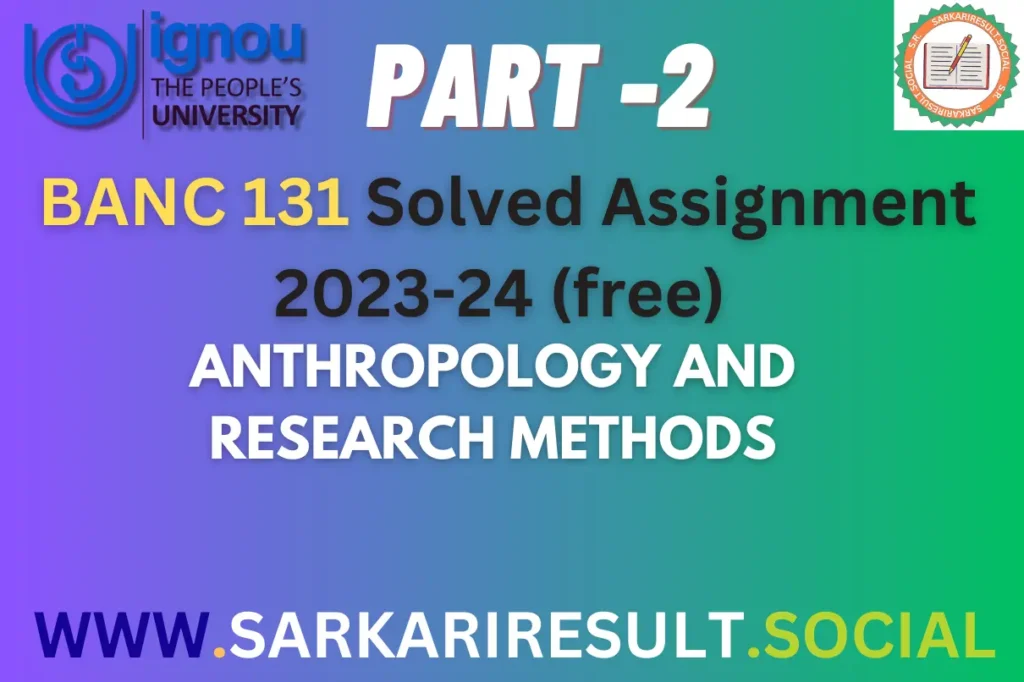BANC 131 IGNOU Solved Assignment 2023-24 (free) Part -2

BANC 131 IGNOU Solved Assignment 2023-24 (free) Part -2
Get ready to excel in BANC 131 IGNOU Solved Assignment 2023-24 (free) Part -2 with our comprehensive solved assignments for 2023-24! This Assignment B evaluates your analytical and concise writing skills through MCQs. Follow the provided instructions and stay within the word limits to maximize your success. Scoring well in these assignments is essential for eligibility in the term-end examination. Enhance your anthropology knowledge and academic performance today! Grab your BANC-131 IGNOU solved assignment 2023-24 now!

Q.3 Discuss the current fields of social anthropology.
Ans. Social anthropology, a branch of anthropology, continues to evolve and adapt to the changing dynamics of human societies and cultures. Today, social anthropology encompasses various fields and areas of research. Here are some of the current fields of interest within social anthropology:
1. Cultural Diversity and Identity: Social anthropologists study how cultures evolve and interact in our globalized world. They explore issues of identity, belonging, and cultural change in multicultural societies.
2. Gender and Sexuality: This field focuses on the roles, expectations, and experiences of individuals based on their gender and sexuality. Social anthropologists examine how these factors influence social structures and relationships.
3. Migration and Diaspora: With increasing migration flows worldwide, social anthropologists investigate the experiences of migrants, their integration into new societies, and the impact of migration on both sending and receiving communities.
4. Conflict and Peace: Social anthropologists play a crucial role in understanding the causes and consequences of conflicts. They study how communities cope with conflict, seek reconciliation, and work towards peacebuilding.
5. Development and Globalization: Anthropologists examine the impact of development projects and globalization on local communities. They assess the effects on cultures, economies, and social structures, often advocating for more sustainable and community-centered approaches.
6. Environmental Anthropology: In response to environmental challenges, social anthropologists explore the relationship between humans and their environments. They study topics like climate change, sustainability, and resource management.
7. Medical Anthropology: This field investigates the cultural aspects of health, illness, and healthcare systems. Social anthropologists explore how different societies perceive and address health-related issues.
8. Urban Anthropology: With the world’s increasing urbanization, social anthropologists study the dynamics of urban life, including migration to cities, urban inequalities, and the cultural aspects of urban communities.
9. Digital Anthropology: As technology shapes our societies, anthropologists examine how digital tools, social media, and virtual communities influence human behavior, relationships, and identities.
10. Indigenous Studies: Social anthropologists often work with indigenous communities, studying their cultures, rights, and the impact of colonialism. They collaborate to preserve indigenous knowledge and advocate for indigenous rights.
11. Political and Economic Anthropology: Researchers in this field explore power dynamics, governance structures, and economic systems within different societies. They examine issues such as political movements, governance, and economic inequalities.
These fields within social anthropology are interconnected and often overlap. Social anthropologists use a variety of methods, including participant observation, interviews, surveys, and archival research, to better understand the complex social and cultural aspects of human life. Their work contributes to addressing pressing global issues and fostering cross-cultural understanding in our increasingly interconnected world.
BANC 131 IGNOU Solved Assignment 2023-24 (free) Part -1
Q.4 Briefly discuss branches of physical/biological anthropology.
Ans. Physical anthropology, also known as biological anthropology, is a subfield of anthropology that focuses on the study of human biological diversity, evolution, and adaptation. It encompasses various branches, each with its unique areas of research. Here are some of the main branches of physical anthropology:
1. Human Evolution: This branch examines the evolutionary history of humans and our ancestors. It explores topics like the origin of bipedalism (walking on two legs), the development of tools, and the emergence of modern Homo sapiens.
2. Primatology: Primatologists study non-human primates, such as apes, monkeys, and lemurs, to gain insights into our own evolutionary history and behavior. They observe primate behavior, social structures, and communication.
3. Human Variation: Researchers in this branch analyze the biological differences among human populations, including variations in genetics, anatomy, and physiology. This field helps us understand the reasons behind traits like skin color, blood types, and susceptibility to diseases.
4. Paleoanthropology: Paleoanthropologists study fossil remains of early humans and hominins (our extinct ancestors). They reconstruct the evolutionary timeline and fill gaps in our understanding of human origins.
5. Bioarchaeology: This field combines anthropology with archaeology to analyze human skeletal remains found in archaeological sites. Bioarchaeologists can determine aspects like age, sex, diet, and health from these remains, shedding light on past populations.
6. Human Growth and Development: Anthropologists in this branch focus on the physical changes that occur throughout a person’s life, from infancy to old age. They study factors influencing growth, nutrition, and health.
7. Forensic Anthropology: Forensic anthropologists apply their knowledge to help solve crimes and identify human remains. They can determine the cause of death, estimate time since death, and identify individuals through skeletal analysis.
8. Dental Anthropology: This subfield specializes in the study of dental anatomy and evolution. Dental anthropologists examine teeth to learn about diet, genetics, and the health of ancient and contemporary populations.
9. Human Osteology: Human osteologists analyze human bones and skeletons to gain insights into the biological characteristics of different populations and individuals.
10. Primate Evolution: This branch focuses specifically on the evolutionary history and relationships among primates, helping us understand the broader context of our own evolution.
These branches collectively contribute to our understanding of human biology, evolution, and adaptation to diverse environments. Physical anthropology often involves interdisciplinary research and collaboration with other scientific fields, such as genetics, archaeology, and ecology, to provide comprehensive insights into the complex nature of human biology and evolution.
Check BSOG 173 IGNOU solved assignment 2023-24 (Free)
Q.5 Describe the development of prehistoric researches.
Ans. The development of prehistoric research is a fascinating journey through time that has reshaped our understanding of human history and the distant past. Here is a concise overview of its evolution:
1. Early Speculations: Before the emergence of systematic prehistoric research, people had various speculations about the origins of ancient artifacts and fossils. These ideas often involved myths, legends, or religious beliefs.
2. Antiquarianism (16th-18th centuries): During the Renaissance and Enlightenment eras, antiquarians began collecting and studying ancient artifacts, fossils, and geological formations. While they lacked modern scientific methods, their efforts laid the foundation for organized research.
3. Emergence of Geology and Paleontology (18th-19th centuries): The development of geology and paleontology in the late 18th and 19th centuries contributed significantly to understanding Earth’s history. This knowledge was vital for dating archaeological sites and fossils accurately.
4. Early Archaeological Excavations (19th century): The 19th century witnessed the first organized archaeological excavations, notably in Egypt and the Near East. Researchers like Heinrich Schliemann uncovered ancient cities like Troy and Mycenae, sparking interest in ancient civilizations.
5. Charles Darwin’s Influence (19th century): Darwin’s theory of evolution in the mid-19th century revolutionized the study of human origins. It prompted inquiries into human evolution and relationships with other species.
6. Formation of Prehistoric Archaeology (19th-20th centuries): Prehistoric archaeology as a distinct field emerged in the late 19th and early 20th centuries. Archaeologists like Sir Flinders Petrie pioneered systematic excavation techniques and chronology development.
7. Radiocarbon Dating (20th century): The invention of radiocarbon dating in the mid-20th century revolutionized prehistoric research. It allowed precise dating of organic materials, significantly refining chronologies.
8. Technological Advances (Late 20th century): The late 20th century brought advanced technologies like ground-penetrating radar, remote sensing, and DNA analysis. These tools enhanced the ability to locate and study ancient sites and human remains.
9. Interdisciplinary Approaches (21st century): Modern prehistoric research often involves interdisciplinary collaboration with genetics, geology, chemistry, and other fields. These collaborations provide comprehensive insights into ancient populations and environments.
10. Ethical Considerations: In recent decades, there has been increased emphasis on ethical considerations, such as respecting indigenous rights, involving local communities, and preserving cultural heritage.
Today, prehistoric research continues to evolve, with ongoing discoveries reshaping our understanding of early humans, their cultures, and the environments they inhabited. It remains a dynamic and ever-expanding field at the intersection of science, history, and anthropology.







